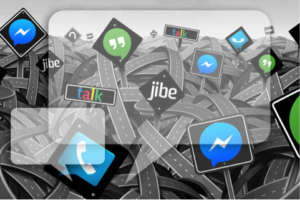Google and its Search for the Perfect Messaging App
By: Sonal Lakhotia, '20 With messaging apps becoming popular over the last few years, new features such as video conferencing and team chats have also begun emerging to cater to different niche groups and interests. Recently, Google repositioned its communication and messaging apps by adding more apps. As of now, Google has added to its number of apps to have a grand total of eight apps directed towards messaging and communication.Google released Hangouts four years ago to try to integrate messaging features into a single platform. However, Hangouts’ interface and usability created issues for users; therefore, it was overshadowed by other messaging apps like Whatsapp and Facebook Messenger (The Verge). Google has repositioned Hangouts for the enterprise by splitting its functionality into two different apps. The two apps, Hangouts Meet (conferencing app) and Hangouts Chat (team messaging apps) will be released later this year (CIO 2017). By releasing these apps, Google hopes to attract users with easy Google Apps Suite integration.In 2016, Google released Allo, another messaging platform with an interesting twist. With Allo, Google added the Google assistant, which would allow users to converse with “@google” and ask questions or have a simple conversation. The chatbot is very intelligent: it understands complicated questions using Google’s Knowledge Graph (The Verge).Google has been trying to cater towards different target markets to try to gain some popularity after the failure of Hangouts. The biggest issue as of now is that Google has too many messaging apps. Handling at least eight or nine apps creates issues with brand identity as well as issues for users who get confused with similar functionalities between the apps. However, Google has ample resources and opportunities to try different platforms to get the best product (CIO 2016). Though the company has many apps, Google will probably try to streamline the apps and keep a few that are successful and suit a large audience. Google’s emergence in the enterprise communication sector could be an interesting trend as it can offer companies many features that are integrated into the app such as the G Suite.As Rahul Castonon-Martinez said, “Google is leveraging its capabilities in machine learning and artificial intelligence to build intelligence and automation into its productivity applications and continues to better integrate social features to cater to team coloration as well as personal productivity” (CIO 2016).Currently, Google is experimenting to find the right app that users need that can successfully compete with other communication apps. The real issue that Google currently faces is whether any app that it releases will be able to successfully attract users from popular apps that have garnered over a billion users such as Whatsapp. Hopefully in the next few years, Google can find the right product catered towards companies and teams that can stand up to Skype and other competitors moving forward. It is just a “wait and watch” game to see what new emergences Google comes up with to add to its large messaging app mix. Sources:http://www.cio.com/article/3179422/collaboration/google-splits-hangouts-in-half.htmlhttp://www.cio.com/article/3112604/instant-messaging/trying-to-make-sense-of-googles-messaging-mess.htmlhttp://www.theverge.com/2016/5/18/11699122/google-allo-messaging-app-announced-io-2016Photo:http://www.cio.com/article/3112604/instant-messaging/trying-to-make-sense-of-googles-messaging-mess.html
With messaging apps becoming popular over the last few years, new features such as video conferencing and team chats have also begun emerging to cater to different niche groups and interests. Recently, Google repositioned its communication and messaging apps by adding more apps. As of now, Google has added to its number of apps to have a grand total of eight apps directed towards messaging and communication.Google released Hangouts four years ago to try to integrate messaging features into a single platform. However, Hangouts’ interface and usability created issues for users; therefore, it was overshadowed by other messaging apps like Whatsapp and Facebook Messenger (The Verge). Google has repositioned Hangouts for the enterprise by splitting its functionality into two different apps. The two apps, Hangouts Meet (conferencing app) and Hangouts Chat (team messaging apps) will be released later this year (CIO 2017). By releasing these apps, Google hopes to attract users with easy Google Apps Suite integration.In 2016, Google released Allo, another messaging platform with an interesting twist. With Allo, Google added the Google assistant, which would allow users to converse with “@google” and ask questions or have a simple conversation. The chatbot is very intelligent: it understands complicated questions using Google’s Knowledge Graph (The Verge).Google has been trying to cater towards different target markets to try to gain some popularity after the failure of Hangouts. The biggest issue as of now is that Google has too many messaging apps. Handling at least eight or nine apps creates issues with brand identity as well as issues for users who get confused with similar functionalities between the apps. However, Google has ample resources and opportunities to try different platforms to get the best product (CIO 2016). Though the company has many apps, Google will probably try to streamline the apps and keep a few that are successful and suit a large audience. Google’s emergence in the enterprise communication sector could be an interesting trend as it can offer companies many features that are integrated into the app such as the G Suite.As Rahul Castonon-Martinez said, “Google is leveraging its capabilities in machine learning and artificial intelligence to build intelligence and automation into its productivity applications and continues to better integrate social features to cater to team coloration as well as personal productivity” (CIO 2016).Currently, Google is experimenting to find the right app that users need that can successfully compete with other communication apps. The real issue that Google currently faces is whether any app that it releases will be able to successfully attract users from popular apps that have garnered over a billion users such as Whatsapp. Hopefully in the next few years, Google can find the right product catered towards companies and teams that can stand up to Skype and other competitors moving forward. It is just a “wait and watch” game to see what new emergences Google comes up with to add to its large messaging app mix. Sources:http://www.cio.com/article/3179422/collaboration/google-splits-hangouts-in-half.htmlhttp://www.cio.com/article/3112604/instant-messaging/trying-to-make-sense-of-googles-messaging-mess.htmlhttp://www.theverge.com/2016/5/18/11699122/google-allo-messaging-app-announced-io-2016Photo:http://www.cio.com/article/3112604/instant-messaging/trying-to-make-sense-of-googles-messaging-mess.html